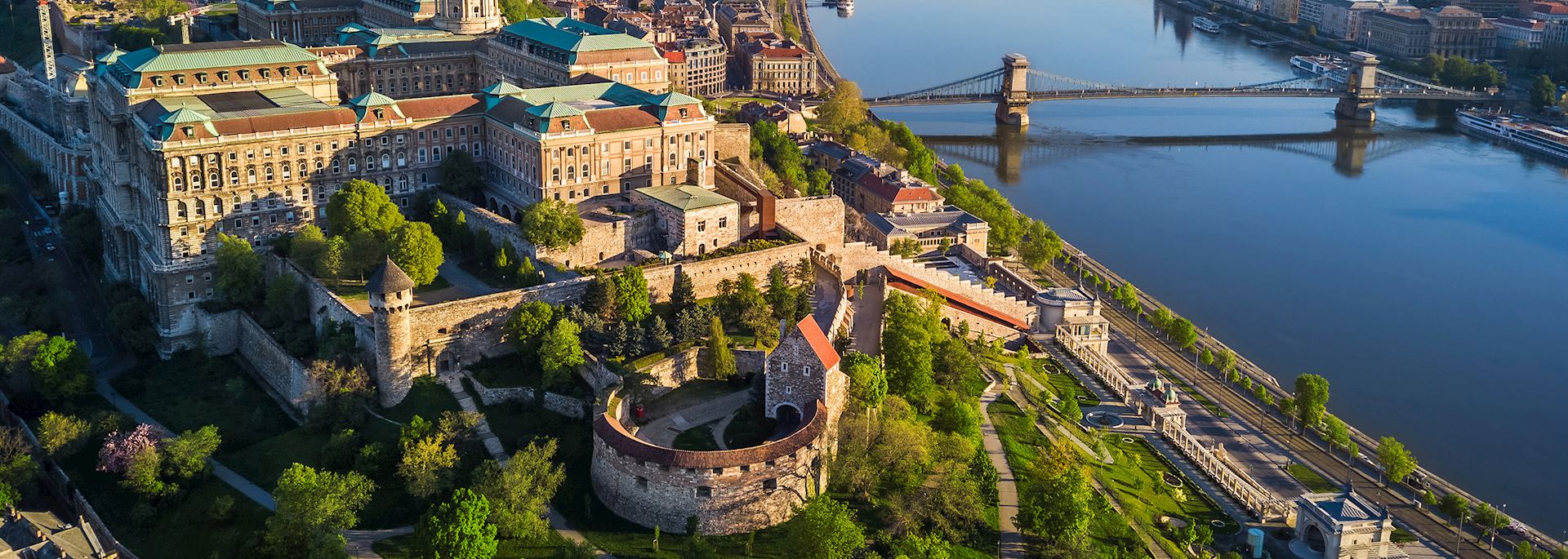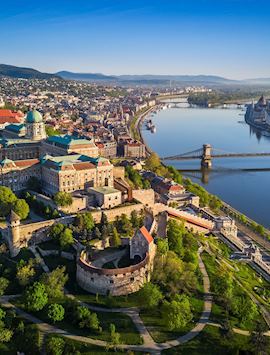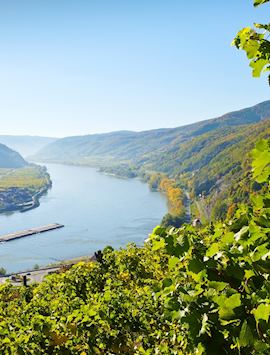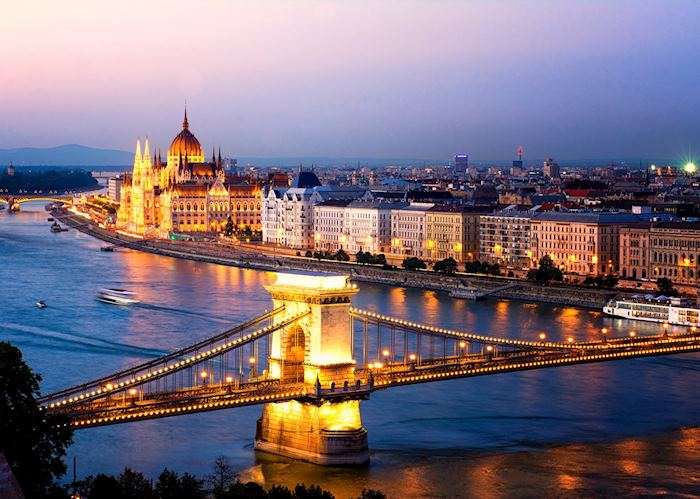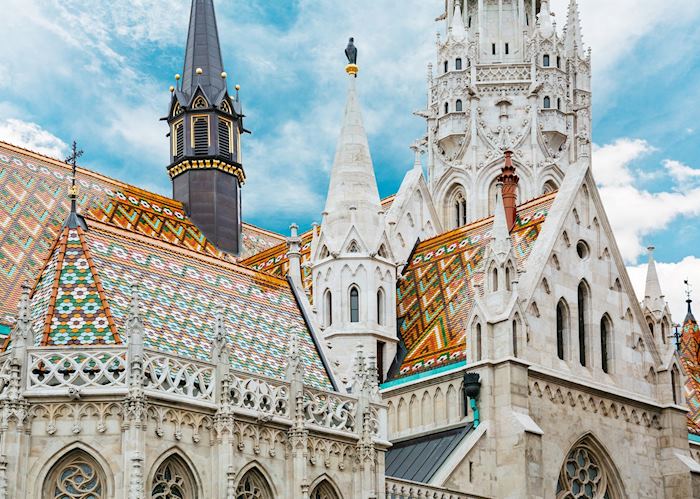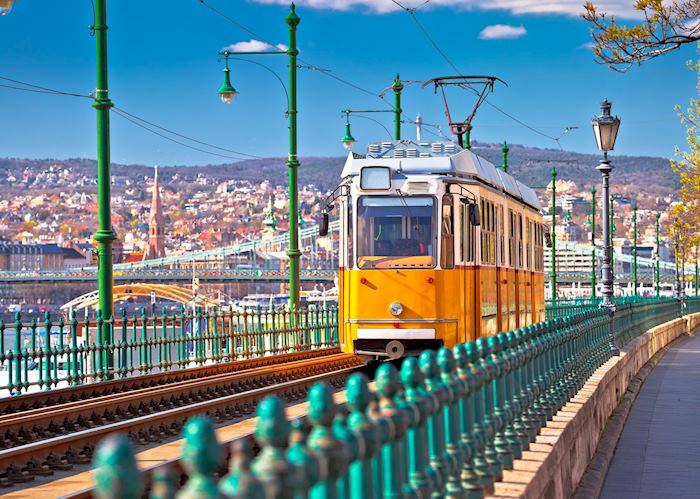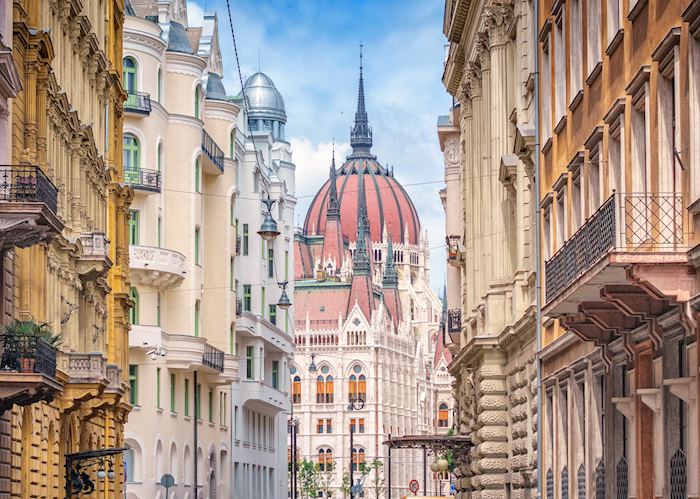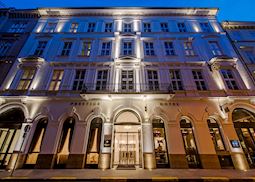Jump to:
Paprika-spiced sausages, Cold War museums, glorious 19th-century architecture, and thermal baths, all in the city of two halves, Budapest.
In Budapest, you’ll find flamboyant fin de siècle architecture, boldly spiced cuisine, and evidence of a tumultuous history that stretches back more than 1,000 years. Even the water makes a statement here, pouring out of the ground in steaming gouts that have been corralled into thermal baths. This is Eastern Europe’s opulent cultural powerhouse and a visit here gives you a chance to explore the region’s distinctive character.
Split in two by the Danube and joined by the Széchenyi Chain Bridge, Budapest is a complicated city, but we can help you discover its past and present. Take tours to sample Hungarian cakes, explore the rich architecture of the city’s 19th-century heyday, delve into its Jewish heritage at the Dohány Street Synagogue and revisit the grim days of the Warsaw Pact on a Cold War walking tour. Or, simply soak up the healing waters at one of the city’s spas.
Things to see and do in Budapest
Castle Hill
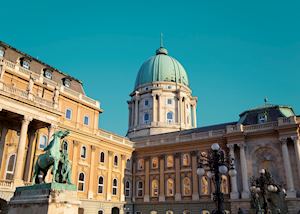 Dominating the Buda side of the city, Castle Hill has been the seat of Hungary’s rulers since Béla IV built a fortress here in the 13th century. That castle was bombed to oblivion during the latter days of World War II — the imposing replacement palace contains the Hungarian National Gallery, the Castle Museum, and the National Széchenyi Library.
Dominating the Buda side of the city, Castle Hill has been the seat of Hungary’s rulers since Béla IV built a fortress here in the 13th century. That castle was bombed to oblivion during the latter days of World War II — the imposing replacement palace contains the Hungarian National Gallery, the Castle Museum, and the National Széchenyi Library.
We can arrange a privately guided tour through the area’s narrow cobblestone streets. You’ll visit the neo-Gothic Matthias Church of our Lady, the seven fanciful turrets of Fisherman’s Bastion, and the red hedgehog in Hess András Square.
Jewish heritage
Before the Nazis invaded, Budapest’s population was about a quarter Jewish. The city’s Dohány Street Synagogue, often called the Great Synagogue, is the second-largest synagogue in the world. It’s a towering gilded monument to 19th-century opulence, with echoes of both Christian churches and Middle Eastern traditions.
You can take a private tour here for an insight into the city’s Jewish heritage and the Neolog denomination, which exists almost exclusively in Hungary. You’ll also see the Tree of Life memorial, a poignant sculpture with branches that resemble an inverted menorah. Each of its long leaves is inscribed with the name of a victim of the Nazis. The tour ends with stops at kosher confectionary shops.
Vajdahunyad Castle
Located in City Park on the Pest side of the city, this eclectic creation was built in 1896 as part of the country-wide millennium celebration that marked 1,000 years since the arrival of the Magyars. It was intended to spotlight every Hungarian architectural style and is a bewildering mishmash of Romanesque, Gothic, Baroque, and Renaissance elements. (The original was built of cardboard, oddly enough.)
Inside, the Hungarian Museum of Agriculture is the castle’s main tenant and you’ll find comprehensive exhibits on the country’s farming heritage, from 15th-century livestock to modern beekeeping.
Hungarian cuisine
Reflecting the grandeur of 19th-century Budapest, the Central Market Hall is set inside a soaring neo-Gothic building. The stalls here do a roaring trade in fresh produce, traditional sausages and salami, Hungarian wines and spirits, and, of course, paprika. Located on the Pest side of the city, near Liberty Bridge, it’s a convenient option for a Hungarian lunch.
You can also visit Gerbeaud, which has been the most fashionable coffee shop in Budapest for a century. Gilded and grand, it offers indulgent cakes and some of the city’s best people watching. For a more in-depth exploration of the country’s distinctive cuisine, we can arrange for a walking food tour.
Cold War remnants
During the Soviet regime, Budapest was the Sin City of the Warsaw Pact thanks to Hungary’s less-restrictive form of so-called ‘goulash communism’. However, the city’s citizens still suffered under the grip of the Communist secret police, who imprisoned, tortured, and killed those they deemed enemies of the state.
You can take a guided tour that explores the remnants of the Iron Curtain culture, starting at the House of Terror. Originally the Nazi headquarters in Hungary, it was later inhabited by the secret police and today functions as both a museum that explores the horrors of these regimes and as a memorial to the police’s victims. The tour also includes a trip to Memento Park, where Cold War statuary is on display.
Ruin bars
In the lean days after World War II, a new tradition emerged among the bombed-out buildings of the Jewish Quarter — ruin bars. With furniture cobbled together from rubble and trash, these bars are now a fixture of the city’s nightlife, if you know where to look. Tucked into rundown buildings, they can be hard to find if you don’t know where to go.
The most popular is Szimpla Kert, which boasts a rusted Trabant and mishmash of house plants as part of its urban decay chic decor. We can take you there or to other, interesting options, where you can enjoy a drink with the locals. The atmosphere is generally noisy and cheerful, with a simple menu that usually consists of just goulash, sausages, and local beer.
Thermal baths
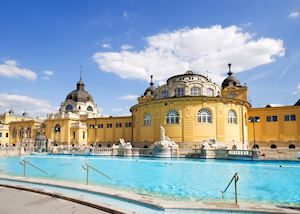 The rock plateau that makes up Castle Hill is honeycombed with tunnels; the result of Budapest’s many hot springs. Locals have long taken advantage of the abundant, naturally warm water by opening baths and spas.
The rock plateau that makes up Castle Hill is honeycombed with tunnels; the result of Budapest’s many hot springs. Locals have long taken advantage of the abundant, naturally warm water by opening baths and spas.
The best-known is the Rudas Thermal Bath, a traditional 16th-century Turkish bath. Its octagonal pool is lit by small windows that pierce the domed cupola overhead. Less venerable but larger, the Széchenyi Bath is a sprawling complex with 16 different pools and even a whirling rapids section. Meanwhile, the Gellért Baths have been restored to their grandiose Art Nouveau style. You can explore all three on a guided tour that examines the culture and history of Budapest’s baths.
Best time to visit Budapest
The months from January to March are very cold in Budapest, while July and August are both hot and crowded. As such, we suggest visiting in the spring months between April and June or during the cooler autumnal months of September or October. Alternatively, you’ll find lively Christmas markets in November and December.
Festivals, events and seasonal reasons to visit
- Sziget Festival (August): One of Europe’s largest music and cultural festivals, held on an island in the Danube.
- Christmas markets (late November and December): Traditional markets fill the city’s squares with twinkling lights. The best is found in Vörösmarty Square.
who's been there
-
617-223-4521617-223-4364
- Make an inquiry
Suggested itineraries featuring Budapest
Our itineraries will give you suggestions for what is possible when you travel in Budapest, and they showcase routes we know work particularly well. Treat them as inspiration, because your trip will be created uniquely by one of our specialists.
Photos of Budapest
Accommodation choices for Budapest
We've selected a range of accommodation options for when you visit Budapest. Our choices usually come recommended for their character, facilities and service or location. Our specialists always aim to suggest properties that match your preferences.
-
![Cortile Budapest Hotel]()
Cortile Budapest Hotel
Budapest -
![Prestige Hotel]()
Prestige Hotel
Budapest
Ideas for experiencing Budapest
Our specialists seek out authentic ways to get to know the places that could feature in your trip. These activities reflect some of the experiences they've most enjoyed while visiting Budapest, and which use the best local guides.
-
Tastes of Hungary — food tour ![Budapest and the Chain Bridge at sunset]()
Tastes of Hungary — food tour
Tastes of Hungary — food tour
From bowls of hearty goulash to sophisticated dessert wines, Hungarian cuisine is a paprika-scented melange of cultural influences and its own distinctive tastes. Embark on a gastronomic exploration on this guided walking tour, which includes cakes, wines, coffee, and sausages.
View details
